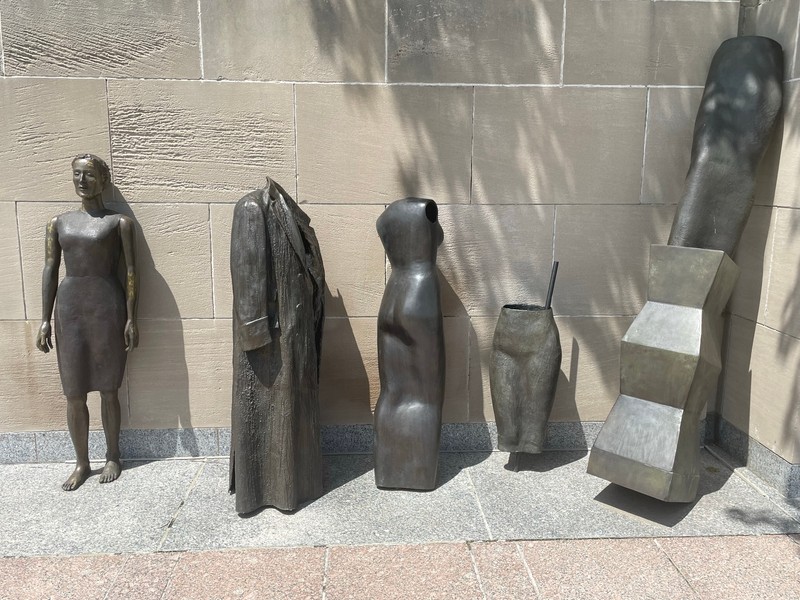Storage
Introduction
Text-to-speech Audio
Created in 1999 by trained fashion designer and artist Judith Shea, Storage is a group of five bronze forms that reflect the artists interest in figuration and textiles. Her early work of flat, minimalistic clothing patterns developed into more figurative work, with molds of draped clothing in human form. Working in life-scale, the bodiless clothing takes on the shape of a human form, evoking presence through absence. The forms of Storage include a barefoot woman in a sheath dress and an empty overcoat, which have been a recurrent theme in Shea’s work since 1981, as well as a headless woman, a lower trunk, and a skirt on a geometric column.
Images
Storage by Judith Shea at the Nelson-Atkins Museum of Art, Kansas City, Missouri

Judith Shea (1948- )

Backstory and Context
Text-to-speech Audio
After first studying fashion design, then graduating from Parsons in New York City with a BFA in 1975, Judith Shea (1948- ) quickly realized she wanted to be an artist. With an interest in the art of textile outside of fashion, she showed her first solo exhibit the following year, which applied color theory in the medium of transparent silk and worn by live models. Then in 1981, Shea presented in the Whitney Biennial showing forms like the iconic overcoat and sheath dress from the 1950-60s, the era of minimalism, which became a recurrent theme in her work. Those forms were displayed on the wall as if they were on hangers, but absent from the human body.
In her early textile work, Shea “was looking for characters, for personae, really, to occupy them,” and “used clothes as stand-ins for people.” Later, she became intrigued with how clothing played a role in how a figure is portrayed and received grants from the National Endowment of the Arts to support endeavors in expanding her skills. She traveled to Paris where she studied garden statuary and also learned techniques of casting in bronze. These experiences led to the creation of life-size, seemingly-hollow figures into the 80s, where she began to evoke the expression of human form through the clothing.
In the 90s, Shea started to embrace the complete human figure, brought in a new medium of wood, and worked on monumental public sculptures. More recently, she's revisited and expanded on her earlier works, while including new techniques and mediums, life experiences, and conveying powerful imagery of societal issues. Perhaps her most powerful work, “The Legacy Collection” was inspired by her eye-witness account of 9/11 and made up of a collection of paired, mannequin-like figures looking to the sky, draped in grey felt clothing and dusted with debris.
Judith Shea has exhibited collections and private commissions around the world and has been recognized with numerous fellowships and awards.
Gallery Label Description
Judith Shea initially worked as a fashion designer. Later, she began making figurative sculptures, a radical idea in the avant-garde world of abstract art. Storage includes a hollow coat and dress, motifs that Shea uses frequently in her work. Shea stated, "They lean propped up against the wall essentially as if forgotten or stored. The truncated clothing forms provided an essence-no extremities, no movement; it was a way to express the essence of human presence."
Storage was purchased from the artist by the Hall Family Foundation and gifted to the Nelson-Atkins Museum of Art in 1999.
Sources
Storage, The Nelson-Atkins Museum of Art. Accessed September 23rd, 2022. https://art.nelson-atkins.org/objects/7762/storage.
Judith Shea, Kent Fine Art. Accessed September 23rd, 2022. https://www.kentfineart.net/judith-shea.
Judith Shea, Artcloud. Accessed September 23rd, 2022. https://artcloud.com/artist/judith-shea.
Photo by David Trowbridge
https://www.thirteen.org/thirteen-celebrates-women/judith-shea/
